This homemade corned beef recipe is easy to make and nitrate free! It is tender and delicious, just like real corned beef is supposed to be. The pickling spices and flavor from the brine make this corned beef have really amazing flavor. Here’s how to make corned beef, just in time for St. Patrick’s Day!
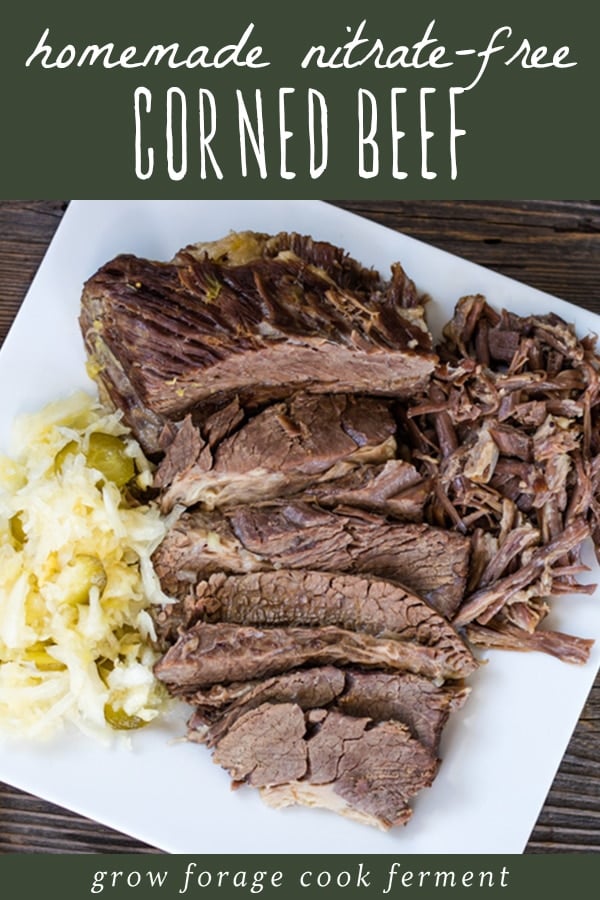
Want to save this post for later?
Homemade Corned Beef
Have you ever had real corned beef? Not the store bought, precooked stuff, but the real deal? There are many delicatessens and butcher shops that make it in house, which is where I had my first taste of it. I was completely blown away at how tender and delicious it was! It was so good, I wanted to learn how make it for myself.
I did some research on how corned beef is made, and realized that it is a cured meat. Curing meat with salt, which is what we’ll be doing here, is similar to fermentation. Corned beef is a bit easier to make than traditional salami or ham, as those need to hang for months at a certain temperature and humidity.
I want to mention here that I don’t call for saltpeter, or pink salt as it’s often called, in this recipe. Saltpeter is a nitrate that is commonly used when making corned beef, mainly to retain its pink color. Many people are trying to avoid added nitrates, and it is not a necessary ingredient when making corned beef.
I’ve made this corned beef many times now, and it always turns out amazing!
Pickling Spice Blend for Corned Beef
The first thing you will need to make is a simple pickling spice blend. You will use some of it in the brine, and some of it when you cook the corned beef after it has been brined. I find it’s easiest to make up a small batch of the spices, then it’s ready whenever I need it.
To make the pickling spice blend, simply mix together equal parts of black peppercorns, mustard seeds, coriander seeds, red pepper flakes, allspice berries, juniper berries, and whole cloves.
These are easily found in the bulk spice section of natural food stores, or you can order them from Mountain Rose Herbs. They even have a premade pickling spice blend that works well!
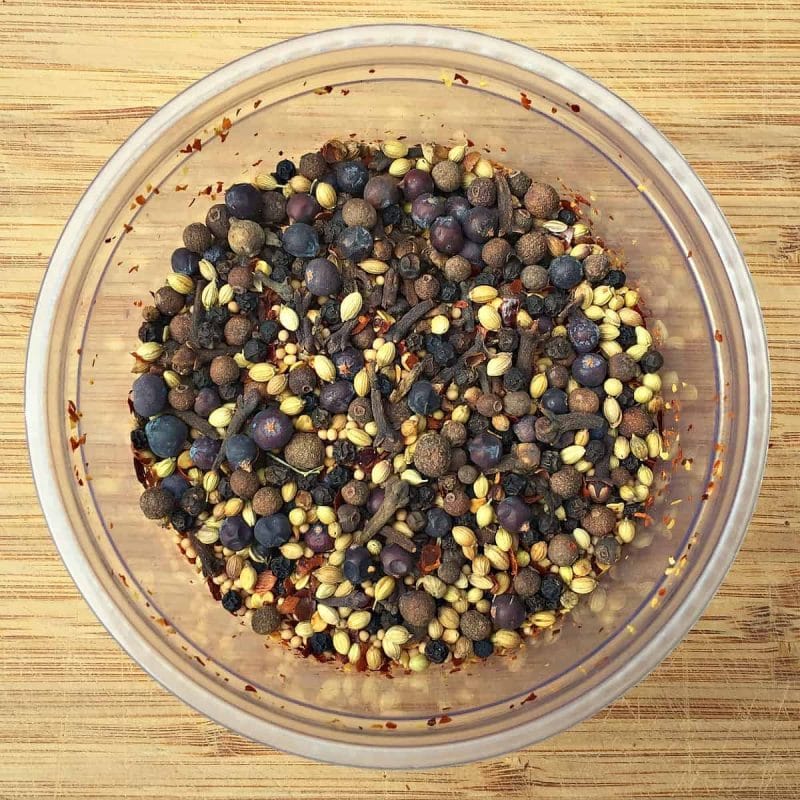
How to Make Corned Beef
The first step in making corned beef is to brine your meat.
Brisket is the cut that is most often used for making corned beef. It is a tough cut of meat that has a lot of connective tissue, but with brining and a long cooking time it can become quite tender.
Like always, I recommend that you buy your meat from a local, grass fed source if possible.
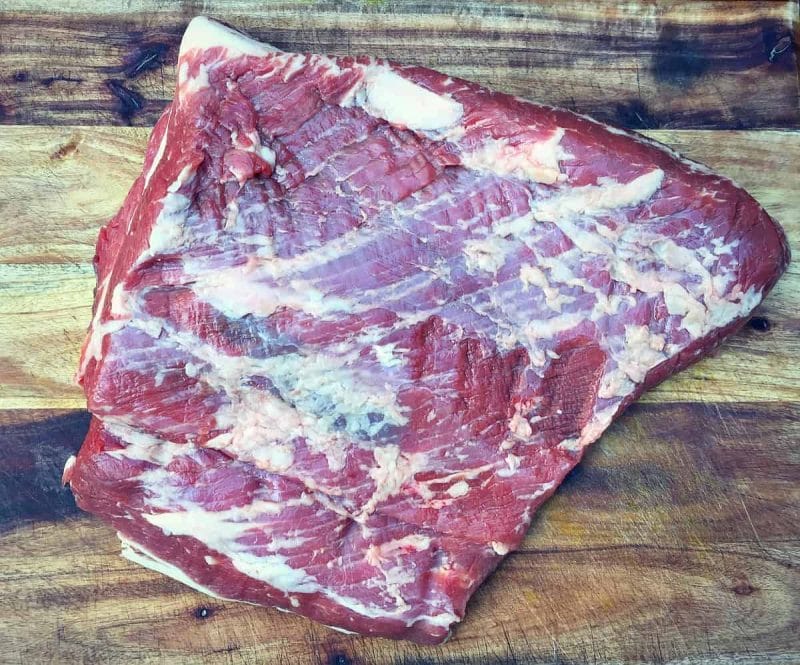
To make the brine, put 3/4 gallon of water, 1 cup of canning and pickling salt (kosher salt will also work), 1/2 cup brown sugar, 2 Tbsp pickling spice blend, 3 crushed garlic cloves, 1 cinnamon stick, 1 bay leaf, and 1/2 tsp ground ginger in a pot and bring to a boil.
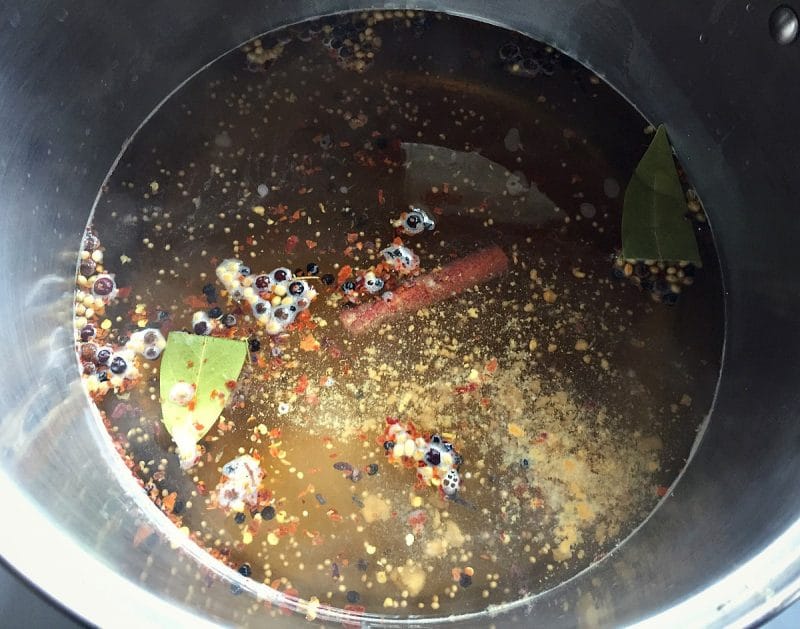
Once it boils, take it off the heat and let it cool completely. Then add the ice cubes and the brisket to the cooled brine and keep it in the refrigerator, covered, for 5-7 days.
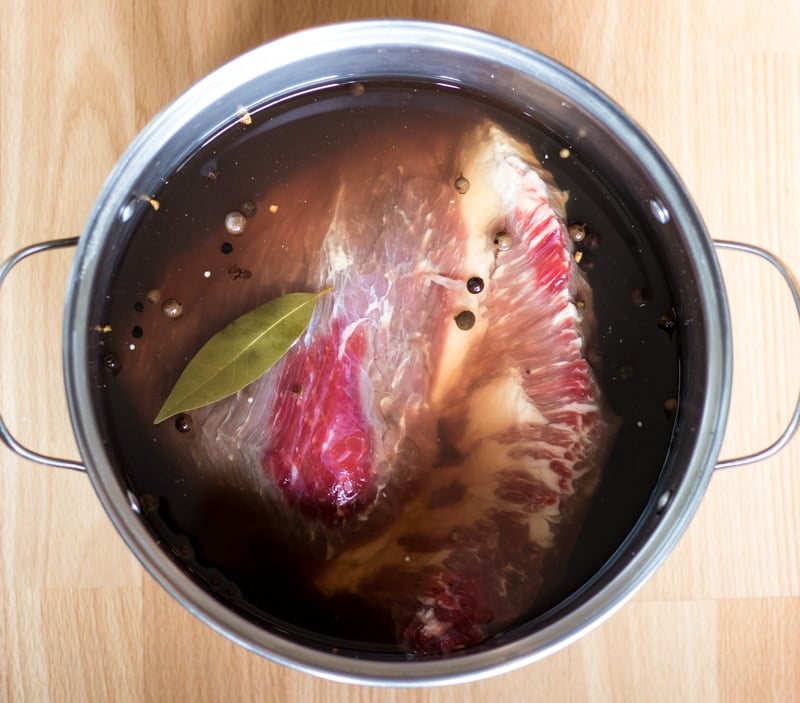
Corned Beef Brining Tips
There are other options if you don’t have the space in your fridge for a large pot of brine.
In the past I’ve put the brisket and brine in a 2 gallon zip top bag that was placed into a casserole dish (in case of leaks) in the fridge, and it worked great.
Another time my fridge was full to the max, so we decided to brine it in a cooler with a block of ice, that we kept outside in the shed. First we put the brisket, cooled brine, and ice cubes into a double plastic bag.
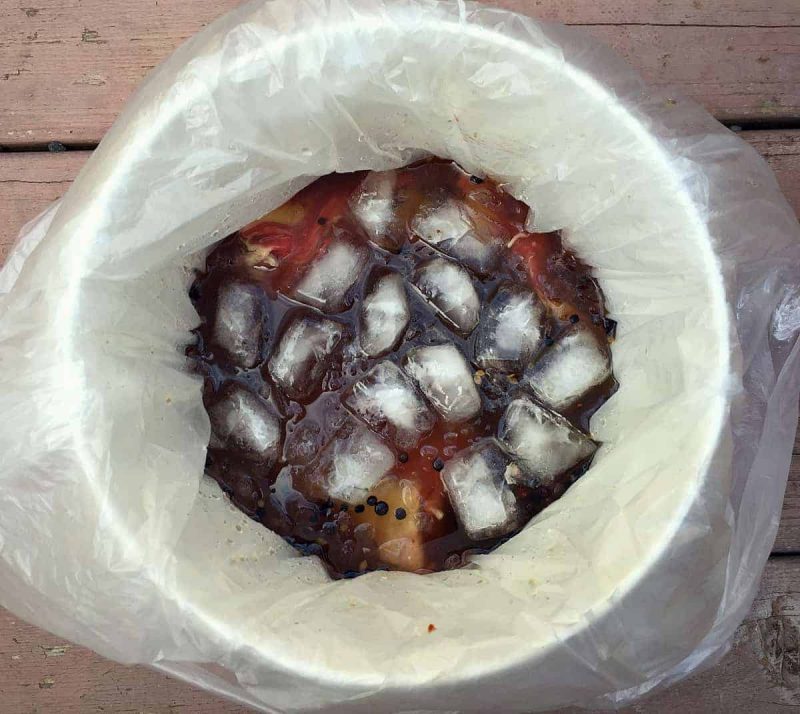
Then we closed the bag with a twist tie, getting as much of the air out as possible. We put a block of ice in the bottom of the cooler, then the bag of brisket and brine on top.
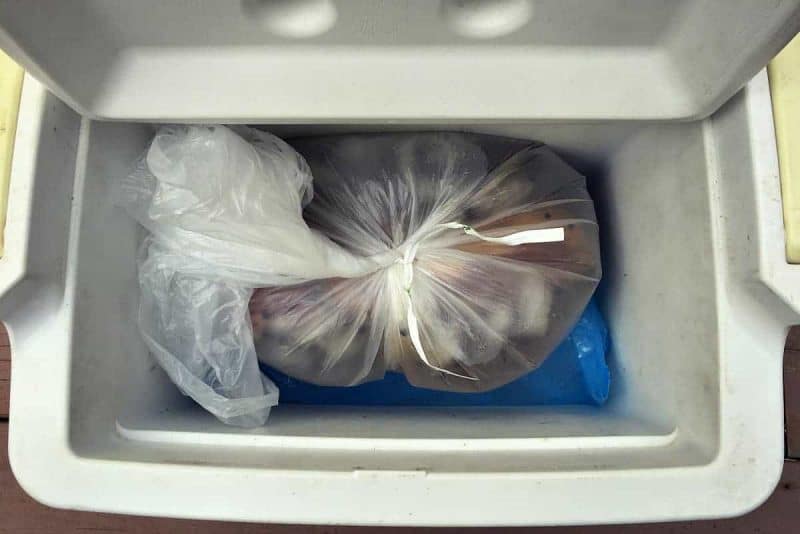
This worked very well for us, and there was still some ice leftover at the end of the week. Be sure to check that you still have some ice in there for the entire brining period as it needs to stay cold, especially if you do this in warmer weather.
Cooking the Corned Beef
After 5-7 days in the brine, it’s time to cook your beef! This will take most of the afternoon, so start early. Take it out of the brine and rinse it well with cold running water. Put it in a pot with water to cover, a halved onion, 2 Tbsp pickling spice, and a bay leaf.
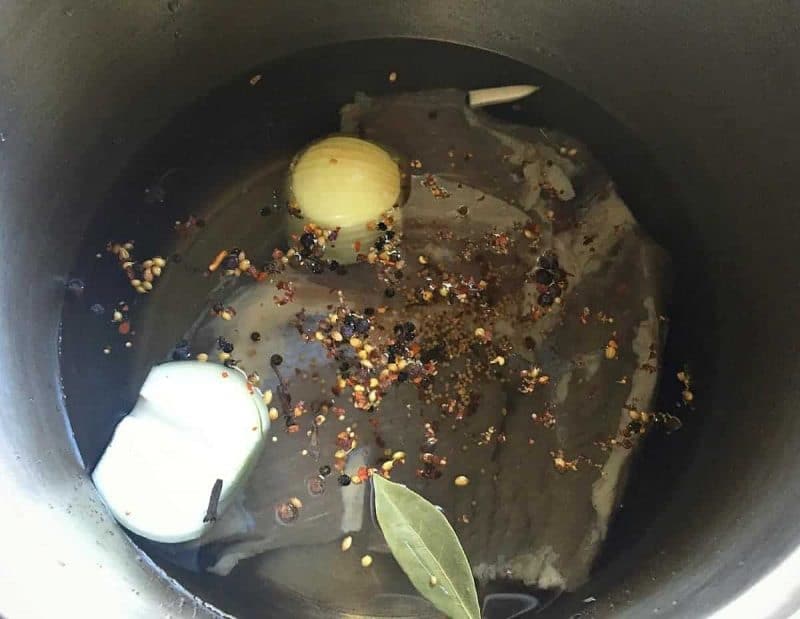
Bring to a boil, then reduce the heat to a simmer. Cover and cook for about 3-4 hours or until the corned beef is tender. If you like, towards the end of cooking, add a quartered cabbage. We did this and it turned out so good! Classic corned beef and cabbage right there.
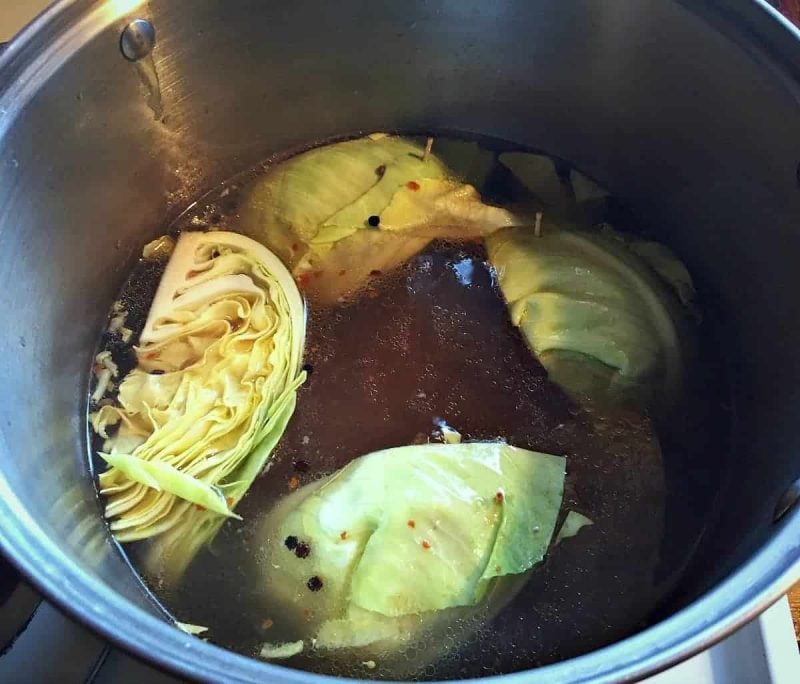
When it’s all finished, both the beef and the cabbage should be tender. Take the corned beef out and cut it in slices against the grain. It should slice quite easily. If for some reason it’s not fully tender yet, keep simmering it for a little while longer until it is.
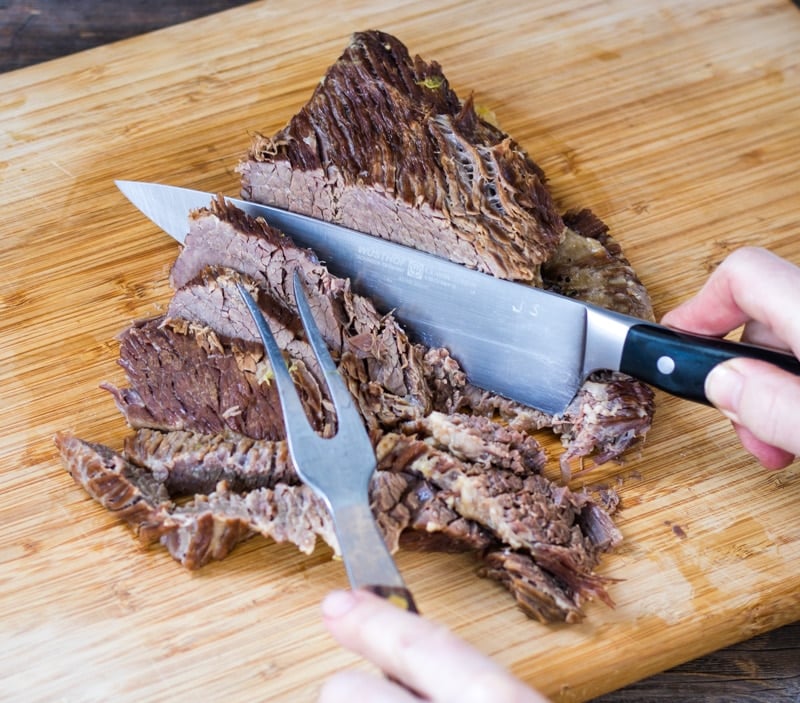
Now, I’m going to tell you the real reason why I made this corned beef. I’m a Reuben sandwich lover, and I need it to make my completely home fermented homemade Reuben sandwich!
If you want to make it here’s what you’ll need: sourdough rye bread, sauerkraut, cheese, and fermented ketchup which is the base for Russian dressing.
This excites me to no end!

I think this corned beef gets even better as it sits in the fridge. It slices easy and is perfect for a corned beef sandwich, even if you don’t have all the makings for a Reuben.
There you have it, your own homemade, nitrate free corned beef! It’s so fun to make traditional recipes at home. I really hope you try it!
Homemade Corned Beef (Nitrate Free)
Ingredients
Pickling Spice Blend
- 1 Tbsp black peppercorns
- 1 Tbsp mustard seeds
- 1 Tbsp coriander seeds
- 1 Tbsp red pepper flakes
- 1 Tbsp allspice berries
- 1 Tbsp juniper berries dried
- 1 Tbsp whole cloves
Brine
- 3/4 gallon water
- 1 cup kosher, pickling, or sea salt or kosher salt
- ½ cup brown sugar
- 2 Tbsp pickling spice blend
- 3 crushed garlic cloves
- 1 cinnamon stick
- 1 bay leaf
- ½ tsp ground ginger
- 3-5 pound beef brisket
- ice cubes
Corned Beef
- 2 Tbsp pickling spice blend
- 1 bay leaf
- 1 onion halved
- 1 head cabbage quartered (optional)
Instructions
- Combine all of the pickling spice ingredients in a small bowl. Store in an airtight container.
- Make the brine by putting all of the brine ingredients, except the brisket and ice cubes, into a pot and bring to a boil. Once it boils, take it off the heat and let it cool completely.
- Put the brisket, brine, and ice cubes into a brining vessel, and keep it in the refrigerator or on ice for 5-7 days.
- Once brining is finished, take the brisket out and rinse well with cold running water.
- Put the brisket in a large pot with water to cover, the halved onion, 2 Tbsp pickling spice, and bay leaf.
- Bring to a boil, then reduce the heat to a simmer. Cover and cook for about 3-4 hours, adding the optional quartered cabbage during the last hour, until tender.
Notes
- Plan to start this at least 5-7 days ahead of time, as that’s how long it takes to brine the meat.
- If you can’t fit the big pot with the brisket and brine in your refrigerator, you can brine it in a 2 gallon zip top bag that is placed in a casserole dish to prevent leaks to save space. You can also brine in in a bag on ice in a cooler.

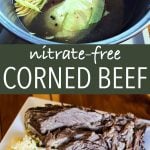
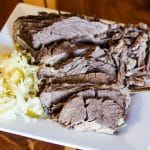

Hi I make corn beef without the spices it turns out good .
I do something different I soak my meat for 2 days just in water it takes theboold out. But have done it without soaking it
Thanks for this! Happy to have found your site. Do you think this will turn out ok without the spices? I realize the taste won’t be as good, but is there another function the pickling spices serve other than taste? I’m omitting spices for a time to try to address some health issues.
I haven’t tried making this without any of the spices, but I think it should still work.
What are the ice cubes for? Do I need them if my brine is cold?
The ice cubes are needed to rapidly lower the temperature of the brine to below the danger zone (40°F-140°F) to prevent growth of foodborne bacteria.
Has anyone tried CANNING beef or venison in this brine? I’m going to give it a shot.
I absolutely love corned beef but despise the nitrates, chemicals, and food coloring etc in commercially corned beef. Terrifying what they put into food these days!
Ideas welcome.
I’ll try to remember to post a follow up in a week or so (can it then give it at least a week, based on the brine directions, to soak up the flavors)
I haven’t tried, but let us know how it goes!
Hi Colleen.
I’m making the brine at the moment, it will be too late for St Patrick’s day, but never mind 😊
I note the use of ice cubes in the brine with the meat, does that not reduce the effectiveness of the brine, or does that not matter?
I ran out of sea salt and topped up the last 1/4 cup with Himalayan salt, is that enough?
Loving your recipes and wild crafting!!
Regards
Lya
I made this dish exactly as you wrote it except I used about 5 lbs of chuck roast. It was delicious and a big hit. Recommend this to everyone. Thank you very much for this recipe.
You’re welcome! I’m so glad you liked it!
I made your corned beef for St Patty’s day this year and followed it up with your Reuben the next day. Both meals were a big hit, but especially the Reuben. I had never attempted to make a corned beef before, but it was so easy and delicious! And for the Reuben, even my picky 5 year old loved it! These two recipes will be on my menu far more often than once a year now. Thank you!
I love corned beef but hate all the chemicals. I’ll definitely be trying this! Instead of cooking on the stove, would your recipe work for a pressure cooker?
I haven’t tried it myself, but I don’t see why not?
I used the instant pot for 75min for a 3lb roast and it was delicious. I then put it on keep warm and added the cabbage till it was cooked. The cabbage was a bit spicy for the kids but was good for adults. Next time, I think I’ll do the cabbage separately but the meat from this corned beef won the taste test between the store bought nitrate version!
Yay! So glad to hear that it passed your taste test!
This turned out perfectly! Why have I been buying corned beef all these years when it is so easy to make?!? Thank you for this awesome recipe and Happy St Patrick’s Day!
I have a half beef in the freezer. Can I use other cuts of meat as well?
You are so extremely cool. Every time you send an email, I always open it, read it, and then read it again aloud to my husband. You are seriously on another level. This corned beef recipe is no exception. I grew up eating corned beef on St. Patty’s day, but now I can make it myself and avoid all the additives. Not to mention how awesome it is for an entire (delicious) sandwich to be fermented. So cool.
I have learned so much by following your site and Instagram over the last few weeks. My husband and I foraged for dandelions for the first time ever, and I fell in love with it! I’m planning to make your dandelion salve recipe as soon as the oil is done. Thank you for sharing what you do with food and herbs. I’m so excited to be part of your community and to learn from you. Your wealth of knowledge is amazing!
Thank you Vanessa!
Definitely making this tomorrow! What a fabulous opportunity to restore ancestral tradition to a familiar (gone-chemical) recipe.
One question: If I were to use Himalayan salt instead of kosher salt, how much would you recommend? I don’t know how much 1/2 cup of kosher salt weighs…perhaps 1/4 cup or so of the Himalayan salt?
Thank you so much for your wonderful blog.
Sorry I got that wrong…I meant I don’t know how much 1 cup of kosher salt weighs…perhaps half or so of the more denser Himalayan sea salt?
Hi Ana, I would use more than 1/2 cup, you really want to make sure that you get enough salt as that is what preserves it while it’s brining. I’m thinking maybe 3/4 cup would be better. You could also look up a salt conversion chart online or even how much one cup of kosher salt weighs.
People should know that the purpose of the curing salt is NOT to give a pink color or a certain flavor, but to prevent the growth of botulism. The salt is colored pink so you don’t mistake it for table salt.
Botulism is not a concern when making corned beef for two reasons. The amount of pickling salt added to the brine doesn’t allow the toxin to grow, and the 3 hour boiling process will also destroy any botulinum toxins that may be present (it doesn’t kill the bacteria, but it DOES kill the toxin which is the part that makes you sick). Adding extra nitrates just isn’t necessary in this case.
Very true!
Take your corned beef to the next level by smoking it after it’s done with hickory and pecan wood. Best Reuben you will ever eat!
Would this work without the sugar or any form of calorific sweetener? ( we have to avoid honey, sugar, syrup, maple, coconut sugar, date sugar etc ).
It would probably work without the sugar, but I can’t tell you what the end results would be as I’ve never tried it.
This is perfect—I’ve never done a corned beef from scratch, have whole brisket in the freezer and another one coming from the cattle butcher.
THANK YOU
A twist on St. Paddy dinner.
(Day 1) Marinate the brisket 24 hours in a liquid smoke, spice and olive oil marinate.
(Day 2) Just before “baking” the brisket add water to the brisket (You
need drippings) and bake until just done. (Cool) Remove the brisket to a
bowl and refrigerate. (This allows the meat to “re-firm-up”). Save
those drippings!
(Day 3- St. Paddy’s Day) Pull your brisket from the
frig and slice into fairly thick steaks. Hydrate with some of the drippings.
Make mashed potatoes and a Spinach salad with bacon bits and blue cheese.
Slice your cabbage and add to the brisket drippings and mix to coat.
Pull Cabbage from drippings and saute with diced onions in cast iron skillet. (Retain drippings and gently heat in a pot)
Fire up the BBQ or Electric grill and grill the brisket steaks. (Remember
they are already cooked so this is just to give it a nice BBQ finish.
When done wrap in foil to keep warm and moist.
Serve up!
With a gravy spoon drizzle the warmed brisket drippings on the top of your spinach salad….it will blow your socks off!
Truly amazing…you are!